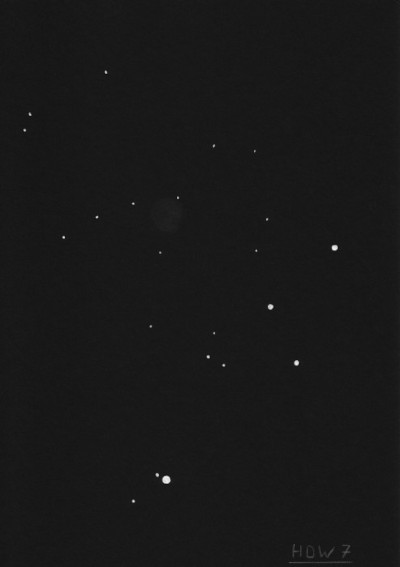A small constellation of the northern sky near the celestial equator, below Gemini and east of Orion, containing only two stars brighter than 5 magnitude: Procyon and Gomeisa. Although located on the edge of the winter Milky Way, Canis Minor offers the observer only a few faint galaxies from deepsky objects, nothing for smaller telescopes. Even binaries are not well represented, but a few are interesting and attention-grabbing. Quasar 4C 05.34, which is one of the most distant object in the sky at 3,000 Mpc, also lies in the constellation.
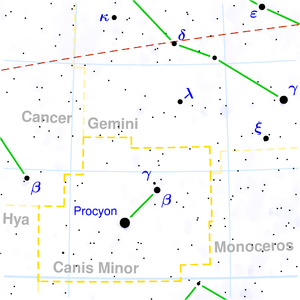
Procyon (α Cmi) - In Greek, it means "before the dog" because when viewed from most places in the northern hemisphere, it rises slightly earlier than Sirius - the Dog Star. It is the eighth brightest star in the sky (0.5 mag) and one of the closest, located 11.4 light-years away from us. Among the bright stars, it is only closer to Alpha Centauri and Sirius. Procyon is easy to find, forming an equilateral triangle with the stars Sirius and Betelgeuse, which spans across the celestial equator and is visible from all latitudes. It is called the Winter Triangle, and its curiosity is that it is best seen above the horizon during the peak of the local summer in the southern hemisphere. Over the course of 1000 years, Procyon will move across the stellar background by the diameter of the Moon, which is 1.25" per year.
14 CMi - Triple star system. The main star has a brightness of 5.4 mag. At a distance of 76", there is a star of magnitude 7, and at a separation of 112", there is a star with a brightness of 8 mag. We can already resolve them with a good eyepiece or a telescope with a 5 cm objective diameter.
Struve 1095 - A binary star for a smaller telescope, two stars with magnitudes of 8.4 and 8.9 are located in the sky at a distance of 10.1". Although it is relatively faint, it can be easily found as it is located 12' SW of γ Canis Minoris and 25' north of β Canis Minoris. When using a magnification of 100x, it appears as a charming small pair with a white primary and a blue secondary component.
Struve 1149 - Double star observed 3 degrees southeast of Procyon, at the western end of the V-Z band of bright stars. In small telescopes, a nice yellow 7.6 magnitude and a blue component of 9.6 magnitude will be visible, a fainter copy of the star Eta in Cassiopeia. In larger magnifications, the companion may take on a purplish hue. Separation is 21.7".
Abell 24
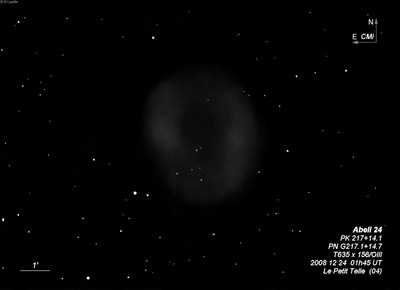
| Type | PN [4(3)] |
| RA | 07:51:37.6 |
| Dec | +03:00:21.0 |
| major_axis | 6.0' |
| minor_axis | 5.5' |
| mag | 13.6 |
| surface_bright | 17.2 |
Abell 22
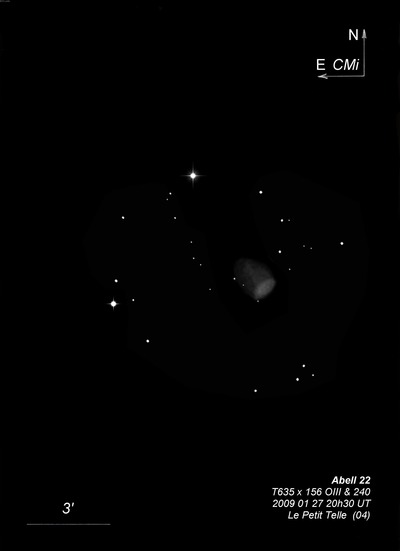
| Type | PN |
| RA | 07:36:07.9 |
| Dec | +02:42:28.0 |
| major_axis | 2.1' |
| minor_axis | 84.0'' |
| mag | 15.4 |
| surface_bright | 16.3 |
Abell 20
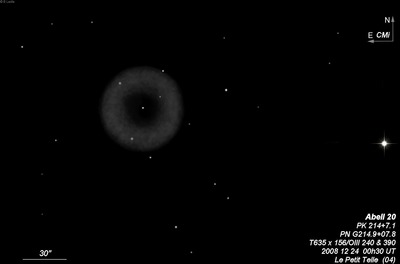
| Type | PN [2c] |
| RA | 07:22:57.7 |
| Dec | +01:45:33.0 |
| major_axis | 66.0'' |
| mag | 16.3 |
| surface_bright | 16.3 |
